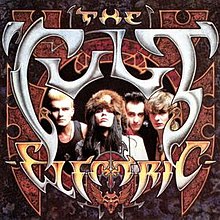Electric (The Cult album)
| Electric | ||||
|---|---|---|---|---|
 |
||||
| Studio album by The Cult | ||||
| Released | April 6, 1987 | |||
| Genre | Hard rock, heavy metal | |||
| Length | 38:51 | |||
| Label | Beggars Banquet, Sire | |||
| Producer | Rick Rubin | |||
| The Cult chronology | ||||
|
||||
| Singles from Electric | ||||
|
||||
| Professional ratings | |
|---|---|
| Review scores | |
| Source | Rating |
| Allmusic |
|
| Robert Christgau | B+ |
| Rolling Stone | (mixed) link |
Electric is the third album by British rock band The Cult, released in 1987. It was the follow-up to their commercial breakthrough Love. The album equalled its predecessor's chart placing by peaking at number four in the UK but exceeded its chart residency, spending a total of 27 weeks on the chart (the most successful run for an album by The Cult).
The album marked a deliberate stylistic change in the band's sound from gothic rock to more traditional hard rock. Rick Rubin, the producer on Electric, had been specifically hired to remake the band's sound in an effort to capitalize on the popularity of hard rock and heavy metal in the 1980s. The album was featured in the book 1001 Albums You Must Hear Before You Die.
In 2013 the album was re-released as a double CD set under the title Electric Peace, with one disc featuring the originally released album and the second containing the entire Peace album recorded during the Manor Sessions.
After the breakthrough success of their second album, Love, the Cult began working on a follow-up with producer Steve Brown. In the summer of 1986, they recorded twelve tracks at the Manor Studio in Oxfordshire. These recordings, which came to be known as the Manor Sessions, were to make up a new album, tentatively entitled Peace. However upon completion of the recording sessions, the band decided that they were unhappy with the sound, and began to look for a new producer.
The band went on to choose Rick Rubin, who was known for producing albums for hip hop artists and thrash metal band Slayer. These new recordings, with a slightly different track-list and running order, became the album that was released.
...
Wikipedia
